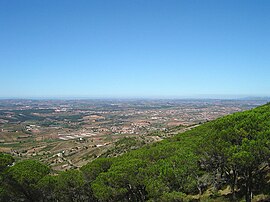Bombarral
Bombarral | |
|---|---|
 The view from the Serra de Montejunto, overlooking Bombarral | |
|
UTC±00:00 (WET) | |
| • Summer (DST) | UTC+01:00 (WEST) |
| Postal code | 2540 |
| Area code | 262 |
| Patron | São Pedro |
| Website | http://www.cm-bombarral.pt/ |
Bombarral (Portuguese pronunciation:
History

It is known that the area of Bombarral was occupied during the geological period, and there exist vestiges of human settlement throughout the municipality, including pre-historic remnants in Gruta Nova, Lapa do Suão and the Neolithic fortifications of Columbeira and the Castro de São Mamede.[3]
Most documented references to Bombarral begin in the 14th century, when the area was under the dominion of the Monastery of Alcobaça.
With the creation of Portugal, King
In the 18th century it was recognized as "Queens lands", and part of the municipality of

The railway connecting Bombarral to Lisbon and Leiria came in 1887, starting a period of accelerated economic development.
Until 1914, Bombarral was a parish of the municipality of neighbouring Óbidos. The present-day municipality was created that year.
Geography
Physical geography
Bombarral is situated in a privileged geographic region in the extreme southern part of the District of Leiria, in the centre of Western Tourist Region (
Bombarral is situated on an alluvial plain that is fertile, with a gentle topography of lowlands.
Human geography
|
Administratively, the municipality is divided into 4 civil parishes (
- Bombarral e Vale Covo
- Carvalhal
- Pó
- Roliça
The A8 is the primary thoroughfare connecting Bombarral with its neighbours.

Twin towns — Sister cities
Bombarral is
Economy
The base of economic activity is agriculture with vineyards predominating, although several crops are routinely rotated within the fields of the municipality.
Notable people
- Ester de Lemos (born 1929 in Bombarral) a university professor, translator and Portuguese writer, member of the National Assembly of Portugal, 1965-1969.
- Armando Costa (1949 in Bombarral – 2012) a Canadian immigrant, Portuguese singer, soccer coach and retired player.
- Margarida Marques (born 1954 in Bombarral) a politician and Member of the European Parliament
- Gabriel Bernardino (born 1964 in Bombarral) a Portuguese mathematician and statistician
References
- ^ Instituto Nacional de Estatística
- ^ "Áreas das freguesias, concelhos, distritos e país". Archived from the original on 2018-11-05. Retrieved 2018-11-05.
- ^ a b c d Câmara Municipal, ed. (2011). "A Nossa Identidade" [Our Identity] (in Portuguese). Bombarral, Portugal: Câmara Municipal de Bombarral. Retrieved 7 April 2011.
- ^ Diário da República. "Law nr. 11-A/2013, page 552 25" (pdf) (in Portuguese). Retrieved 18 July 2014.
